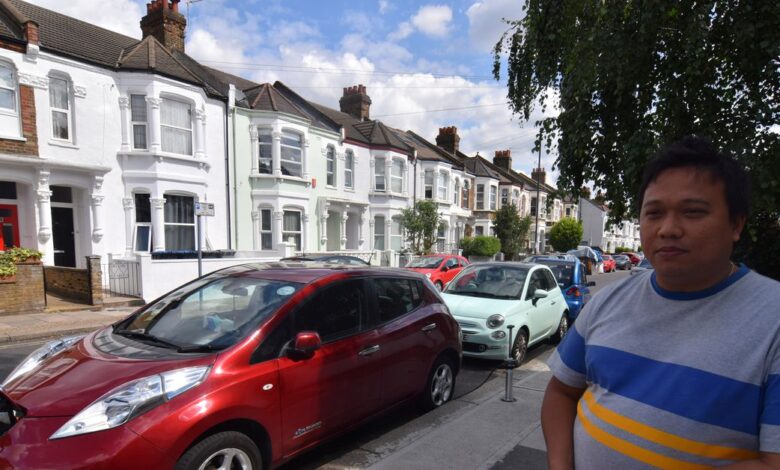Rocking down to Electric Avenue? Good luck charging your car

LONDON, Oct 13 (Reuters) – European and U.S. cities planning to part out combustion engines over the following 15 years first must plug a charging hole for hundreds of thousands of residents who park their vehicles on the road.
For whereas electrical automobile (EVs) gross sales are hovering in Europe and the USA, a lag in putting in charging infrastructure is inflicting a roadblock.
Typically cash-strapped native authorities produce other priorities than a kerbside community of charging factors which might enable house owners to make sure their EVs are at all times topped up.
And whereas that leaves a possible hole for the non-public sector, it’s one which few EV charging startups, who’ve been early adopters in different areas, are centered on.
“It is actually troublesome to deal with on-street residential charging, so there’s actually not many corporations which have,” Hugh Mackenzie, chief working officer at Trojan Vitality, stated.
Trojan has developed a charger, which is being examined on residential streets in two London boroughs, the place EV house owners insert a brief pole into sockets sunk into the pavement after which plug of their automobile.
Tim Win, an Uber driver who fees his Nissan Leaf on daily basis, is utilizing the system in Brent, north London.
“After I have been driving all day I simply need to come residence and plug in,” stated Win, 39, who beforehand used a close-by EV quick charger to cost up in 20 minutes however generally needed to wait in line for practically an hour.
A “cabbie” utilizing one among London’s new electrical black taxis instructed Reuters he usually has to drive between charging factors, dropping priceless customized as he does, solely to search out they’re both already in use or malfunctioning.
COST CURB
Just like the roll out of fibre optic cable for ultra-fast broadband, city on-street charging utilizing options which embody lamp submit chargers and even wi-fi, will price billions.
Options like Trojan’s are costly as a result of they require grid connections. And since there aren’t but sufficient EV house owners to make sure a fast return, they’re 75% backed by Britain’s authorities.
Trojan’s chargers price round 7,000 kilos ($9,520) to make and set up, however Mackenzie says that if that may be minimize to 4,500 kilos it should work for personal traders.
However it nonetheless requires native authority buy-in.
“The most important think about whether or not kerbside charging is profitable is whether or not you will have an and engaged municipality,” stated Travis Allan, vp for public affairs at Quebec Metropolis-based FLO, which has put in no less than 7,000 kerbside chargers in Canadian and U.S. cities.
But even engaged native authorities like Brent, which is attempting lamp submit chargers and different options, merely lack money.
Tim Martin, Brent council’s transportation planning supervisor, says lamp submit chargers price round 2,000 kilos and fast chargers round 15,000 kilos, so subsidies are the one possibility.
“The prospect of with the ability to fund them ourselves out of our personal budgets is virtually zero,” Martin stated.
Primarily based on automobile registrations and parking permits, charging startup char.gy estimates there are between 5 million and 10 million vehicles in London, of which round 76% park on the road.
Authorities figures present the full is round 40% for Britain’s 33 million vehicles, whereas round 40% of Individuals don’t reside in single-family houses with garages.
And whereas the rise of automobile sharing companies could scale back the necessity for on-street charging, it’s unclear by how a lot.
Char.gy Chief Govt Richard Stobart estimates Britain will want half one million on-street chargers by 2030, when round half of the nation’s vehicles ought to be electrical. Char.gy runs a community of round 1,000 on-street lamp submit chargers in Britain that price round 1,800 kilos to make and set up.
Whereas authorities subsidies exist, Stobart stated, native authorities usually lack the assets.
“So they simply dither and it takes without end,” he added.
Ubitricity, a Royal Dutch Shell enterprise, is the British market chief, with simply 4,000 chargers utilizing lamp posts, which if they’re shut sufficient to the kerb and use LED lamps, have sufficient energy to largely cost an EV in a single day.
Lex Hartman, ubitricity’s CEO, estimates that in densely-populated areas, round 60% of Europe’s automobile house owners will want public charging.
“You will want chargers at residence, at work, on the grocery store, you will want quick charging, however primarily you want charging in every single place,” Hartman stated.
“If the infrastructure is not there then folks will hesitate to purchase an electrical automobile until they’re compelled to,” he added.
Europe has greater than 90 million lamp posts, hundreds of thousands of which can be utilized for charging, stated Hartman, whose ubitricity additionally runs a lamp submit charger community in Berlin.
The European Fee is aware of city chargers “will likely be important to convincing increasingly more shoppers to go electrical,” and has shaped an professional group to advise cities on how you can deploy them, a spokesperson stated.
‘PAINFUL EXPERIENCE’
Some cities face an enormous problem.
New York state has set a objective for all new passenger vehicles and light-duty vans to be zero-emission by 2035.
However New York Metropolis presently has simply 1,580 charging plugs for round a million vehicles that depend on avenue parking.
“Proudly owning an EV in a big metropolis like New York is a extremely painful expertise,” stated Paul Suhey, co-founder of electrical moped sharing startup Revel, which has launched the town’s first fast-charging hub.
An April examine commissioned by New York estimated electrifying its transportation would price some $500 billion.
In Los Angeles, which has essentially the most chargers of any U.S. metropolis, Blink Charging final 12 months purchased city-run EV automobile sharing community BlueLA, which has 100 autos and 200 charging stations.
Blink CEO Michael Farkas stated native authorities need charging infrastructure in as many locations as potential to encourage folks to purchase EVs, however corporations can’t afford to shoulder the investments till possession rises.
“You may’t simply have a subject of desires, you may go broke until the federal government desires to pay for it,” Farkas stated.
Even in Norway, the place state assist put it on the forefront of the electrical shift, rolling out on-street charging is hard.
Oslo subsidizes bigger public chargers and fast chargers, investments that repay inside three to 6 years, Sture Portvik, who heads up its charging infrastructure efforts, stated.
However making charging accessible for the 30% of automobile house owners who lack designated parking in a metropolis the place bans on fossil-fuel vehicles will begin within the subsequent few years is a significant problem.
“It is extraordinarily vital that everyone, no matter their financial background, will get to be part of the inexperienced shift,” Portvik stated. “And so they must as a result of in just a few years they must promote their diesel automobile.”
($1 = 0.7354 kilos)
Further reporting by Kate Abnett in Brussels; Modifying by Alexander Smith
:





